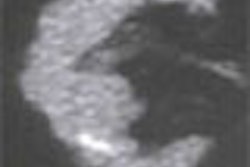Organs with rapidly dividing cell systems, including bone marrow, intestines, and gonads, are known to be more sensitive to ionizing radiation than other anatomic regions.
For gonads in particular, a threshold radiation dose of 350-600 cGy may be sufficient to produce permanent sterility. Animal studies suggest that a gonadal radiation dose of 100-150 cGy will produce a genetic mutation rate equal to the baseline spontaneous mutation rate in humans, though mutations have been seen more rarely in the offspring of exposed individuals.
From an anatomic and engineering standpoint, however, gonadal shielding is a straightforward affair. Lead pelvic shields were ubiquitous back when abdominal x-ray was common. But shielding fell out of favor with the rise of multidetector-row CT, which avoids direct exposure to the testes during the abdominal exam. And according to researchers from Germany, radiologists may have abandoned shielding because they consider CT's multidirectional x-ray source more difficult to shield against.
But protection is effective and fairly easy to provide, Dr. Christian Hohl, Dr. Andreas Mahnken, and colleagues from the University of Aachen in Germany wrote in January's American Journal of Roentgenology.
"The ALARA principle (as low as reasonably achievable) describes best the concept of radiation protection," they wrote. "Any protection measure that is easy to use, does not impair image quality, and significantly reduces x-ray exposure should be used" (AJR, January 2005, Vol. 184:1, pp. 128-130).
So the group set out to quantify the effect of a standard gonadal shield on testicular radiation exposure due to scatter radiation during abdominopelvic CT. To that end they performed routine abdominopelvic MDCT scans in 34 patients with gonadal lead shielding (mean age 61.5 ± 12.7 years) and 32 patients without (mean age 60.4 ± 15.5 [SD] years), then estimated the testicular radiation dose for both types of exam with thermoluminescent dosimetry, adjusted for body weight and body mass index (BMI).
The 1-mm-thick lead shielding device (Testes-Capsule TK, Dr. Goos-Suprema, Heidelberg, Germany) comes in two sizes. Technicians told the patients how to attach the capsules themselves. Before each exam the thermoluminescent dosimeter was affixed as close as possible to a testicle with adhesive tape, the authors wrote.
All of the exams were performed with a 16-detector scanner (Somatom Sensation 16, Siemens Medical Solutions, Erlangen, Germany) using a routine abdominal protocol that included 120 kVp, 150 effective mAs, at 16 x 1.5-mm collimation, and gantry rotation speed of 0.5 sec. Before scanning, the patients received 100 mL of iodinated contrast medium (iopromide, Ultravist 370, Schering, Berlin). The radiation dose with and without gonadal shielding was measured, compared, and analyzed.
The results showed the use of the shielding device decreased the mean testicular dose from 2.40 to 0.32 mSv, a reduction of 87%, and the difference between the two exams was significant (p < 0.0001). Image quality was not affected by beam-hardening artifacts in any of the exams. There was no correlation between dose reduction and the patient's body weight or BMI, they wrote, probably because diameter variations in the lower pelvis were minor in the patient cohort.
A few reports have been written on the subject, but "to the best of our knowledge, no reports have been published on the effect of gonad shielding in routine clinical MDCT examinations," the authors wrote. Still, the group's 87% drop in radiation is very much in line with reductions of 77% (Price et al, British Journal of Radiology, May 1999, Vol. 72:857, pp. 489-494) and 95% (Hidajat et al, Rofo, November 1996, Vol. 165:5, pp. 462-465) seen in previous single-detector CT phantom studies, they noted.
"The capsules that we used are commercially available, easy to use, and well accepted by patients," the authors added. "We can recommend routine use of gonadal shields in male patients undergoing abdominopelvic MDCT examinations and therefore the incorporation of the shields into the daily routine."
By Eric Barnes
AuntMinnie.com staff writer
January 10, 2005
Related Reading
Biodex raises shielding options, September 24, 2004
Pediatric CT won't stop growing, but dose can be minimized, May 8, 2003
Radiation hormesis and the radiologic imperative, March 21, 2003
Studies cast doubt on low-level radiation dangers, January 30, 2003
Copyright © 2005 AuntMinnie.com




















